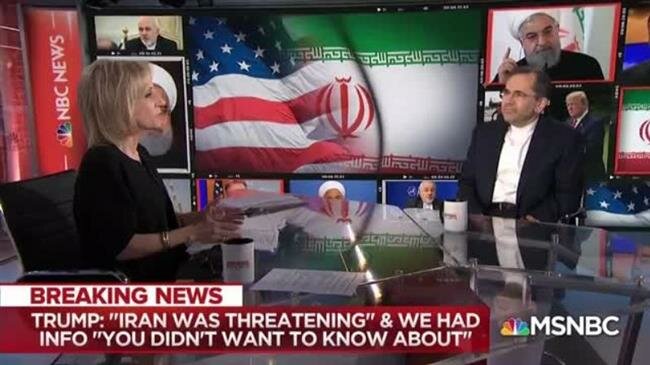Iran rejects Trump’s call for talks after reneging on deal
Iran’s envoy to the UN has rejected President Donald Trump's call for new negotiations with Tehran, saying Trump's withdrawal from the 2015 nuclear deal signals that he may "renege again" on any future talks.

“All of a sudden he decided to leave the negotiating table. What is the guarantee that he will not renege again on the future talks between Iran and the United States?” said Majid Takht Ravanchi in an interview with the MSNBC TV network Thursday.
The Iranian envoy stressed that Trump had “torn up” the deal despite the fact that it was a multilateral nuclear accord signed by world powers and backed by the UN Security Council.
“The president [Trump] just said that what he wants from Iran is to not have nuclear weapons, apparently he hasn’t read the 14 reports of the International Atomic Energy Agency (IAEA) saying that Iran has been upholding all its obligations based on the JCPOA nuclear deal,” Takht Ravanchi added.
The UN envoy’s comments came after the US president called for negotiations with Iran earlier on Thursday amid escalating tensions over the administration’s increasingly hawkish policy towards the Islamic Republic.
Last year, Washington withdrew from the Joint Comprehensive Plan of Action (JCPOA) and reimposed unilateral sanctions that had been lifted under the deal on Iran.
Last month, the US said it would not renew waivers that allowed Tehran’s eight largest customers to purchase its oil in a bid to cut Iranian oil exports to zero and exert maximum pressure on Iran. The waivers expired on May 1.
Asked whether Tehran would continue to comply with the nuclear deal following the US withdrawal, Takht Ravanchi said the deal had been greatly undermined by Washington and that Iran would respond based on its national interests.
“Europeans have told us not to rush to get out of the nuclear deal, and we accepted their suggestion and for the last year we have been waiting for any credible and practical response, not just words of support, which are good, but it is not enough,” he said.

-European security experts urge US to return to Iran dealAlmost two dozen European security experts call on the US to return to the 2015 nuclear deal with Iran on the first anniversary of Washington’s unilateral withdrawal from the historic accord.
Iran has complained to Europe for its long-delayed implementation of a promised European financial mechanism designed to bypass US sanctions.
On Wednesday, Iran’s President Hassan Rouhani announced a decision made by the Supreme National Security Council (SNSC) for the country to suspend the implementation of part of its commitments under the JCPOA.
According to the decision, Iran will stop selling its excess low-enriched uranium and heavy water as it was contractually obliged under the nuclear deal.
Rouhani said Iran would take further steps in 60 days if the other signatories failed again to ensure that it still benefited from staying in the nuclear accord despite the US’s withdrawal.

Iran scales down commitments under JCPOAOne year after US president unilaterally withdrew the US from the Iran nuclear deal and reinstated sanctions, Tehran has announced counter measures.
The move came after Washington also imposed new sanctions against Iran’s enriched uranium exports and metal and mining sectors in the past week.
On Tuesday, US Secretary of State Michael Pompeo paid a surprise visit to Iraq to discuss “big energy deals that can disconnect them from Iranian energy.”
The abrupt trip to Baghdad happened after Pompeo cancelled a previously scheduled trip to Germany, prompting many observers to speculate that the hastily-planned trip to Iraq was related to escalating tensions targeting Iran.
‘Fake intelligence’
The Iraq visit came just days after White House national security adviser John Bolton announced that the US was deploying an aircraft carrier strike group and a bomber task force to the Middle East in a bid to send a “message” to Iran.
Trump later said the deployment had happened because information had been obtained showing that Iran was “threatening” the US.
Speaking on Thursday, Takht Ravanchi slammed the allegations, saying they were based on “fake intelligence”.
“These are all allegations that are being produced by the same people who in the run-up to the US invasion of Iraq, did the same,” he said, referring to the US’ false claims of Iraqi weapons of mass destruction (WMDs) that led to the 2003 invasion of Iraq.
On Tuesday, the American Daily Beast news website cited informed US government sources as saying that the Trump administration had “inflated” the alleged “threat” from Iran.
“In this case, there is not a consensus in intelligence and military circles on whether the administration’s interpretation, used to justify the deployment of an addition US aircraft carrier and Air Force bomber task force to the Persian Gulf, was accurate,” read the report.
Some congressional Democrats have also expressed concern that the Trump administration may be trying to provoke a wider conflict with Iran.
“The response seems wildly out of proportion,” said a senior Democratic congressional official briefed on the intelligence.
Iranian officials, however, have dismissed the allegations as being part of the administration’s “psychological warfare” against the country.
The #B_Team is at it again: From announcements of naval movements (that actually occurred last month) to dire warnings about so-called “Iranian threats”.
If US and clients don’t feel safe, it’s because they’re despised by the people of the region— blaming Iran won’t reverse that.







